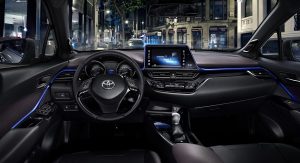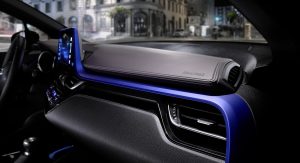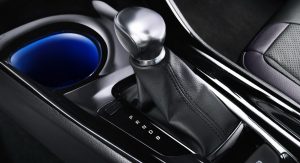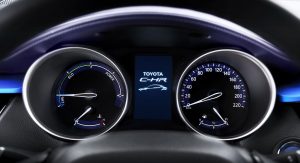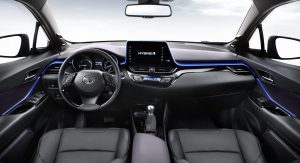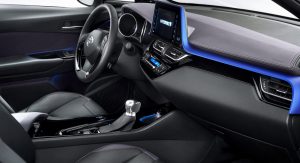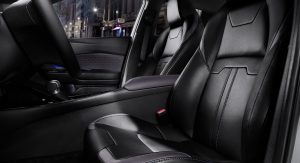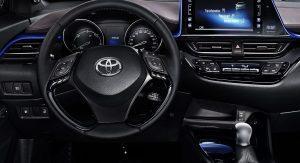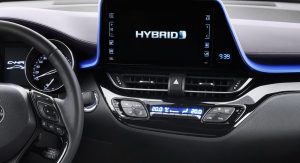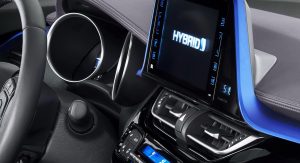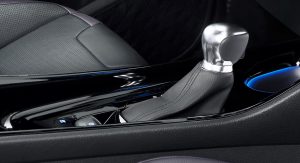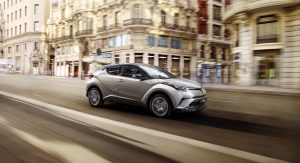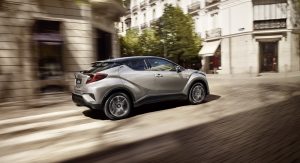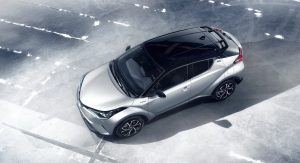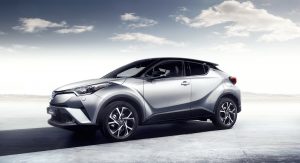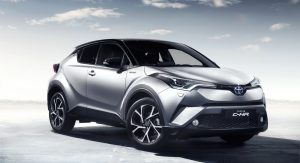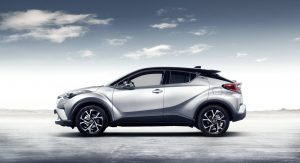Toyota has finally given us an inside glimpse of their upcoming 2017 C-HR following its debut at the Geneva Motor Show in March where it was displayed with blacked out windows.
The C-HR represents Toyota’s jump into the hotly contested subcompact crossover segment, going up against the likes of the Honda HR-V, Nissan Juke, Mazda CX-3 and the Buick Encore and Opel Mokka twins, with sales in Europe to start this fall, and in North America and other regions around the world, in the first half of 2017.
Having already seen the production C-HR’s hip exterior styling with a coupe-like build, aided by the concealed rear door handles, angular lines and pronounced wheel arches that work well when filled with big wheels like on the Geneva show floor model, Toyota has now lifted the curtains on the car’s cabin.
The CH-R’s asymmetrical dashboard has a simple and uncluttered layout, minimizing switchgear thanks to a large 8-inch touch-screen featuring a redesigned and improved HMI (Human Machine Interface) with Toyota’s Multi-Media ’16 navigation platform and enhanced connected services. All operating switchgear and the display are slightly oriented towards the driver.
Toyota says it’s aware that C-HR customers will also have competitors from premium brands on their shopping list and claims to have made steps forward in perceived quality. The cabin combines a “careful choice of finishes” that include leather-like material for all background surfaces, a smooth Nappa grain for all touching surfaces and technical grain for all functional elements such as switchgear, along with decorative elements finished in “high quality” piano black and satin silver trim.
“Our aim as Toyota’s European design centre was to deliver a unique style – modern and sensual at the same time,” said Alexandre Gommier, from Toyota’s ED2 Design Centre. “The uniqueness of the C-HR’s interior design is based on a stable structure with ‘Emotional Surfaces’ and ‘Innovative Details. These key features provided us with the opportunity to approach the design with a fresh perspective. As a result, the C-HR showcases the emotional appeal of Toyota’s interiors of the future.”
The C-HR will offer three interior color combinations: Dark Grey, Black & Blue and Black & Brown, while some of the available features will include heated seats, a smart entry system, privacy glass, bespoke upholstery with part-leather seats, Toyota’s S-IPA system (Simple Intelligent Park Assist), 18” alloy wheels, Bi-tone metallic paintwork and a JBL premium audio system comprising an 8-channel, 576 Watt stereo amplifier and 9-speakers.
Toyota’s Safety Sense system will be standard across the range – at least in Europe. The system includes a Pre-Collision System (including Pedestrian Recognition), Adaptive Cruise Control, Lane Departure Alert with steering control, Automatic High Beam and Road Sign Assist (not available on the entry grade).
Measuring 4,360mm (171.7 in.) long, 1,795mm (70.7 in.) wide, and 1,555mm (61.2 in.) tall (Hybrid), with a 2,640mm (103.9 in.) wheelbase, the C-HR will offer 370 liters of boot space with the rear seats in place.
Europeans will be able to choose between two powertrains. The base model comes with a 1.2-liter turbocharged four petrol producing 114hp (116PS) and 185Nm (136 lb-ft) of peak torque that can be mated to either a 6-speed manual or a Continuously Variable Transmission, the former exclusively with front-wheel drive, and the latter, optionally with all-wheel drive. This unit generates CO2 emission from 128 g/km and returns a combined fuel consumption as low as 5.7 l/100 (41.3l mpg US / 49.6mpg UK).
Instead of a diesel, Toyota opted for a hybrid model utilizing the same Hybrid Synergy Drive setup as the latest Prius with a 1.8-liter petrol engine working with an electric motor to deliver 120hp (122PS). Toyota says the C-HR Hybrid returns a combined fuel consumption of 3.7 l/100 km (63.6 mpg US / 76.3 mpg UK) with CO2 emissions of just 85g/km.
Certain markets, including Ukraine and Caucasus, will also get a 150PS (148hp) 2.0-liter petrol engine paired exclusively to a CVT, while Toyota officials have hinted at a higher-performance version as well.
Toyota hasn’t confirmed any powertrains yet for the US and Canadian markets where the C-HR will go on sale next year.



![2017 Toyota C-HR Small Crossover’s Interior Revealed [w/Video]](https://www.carscoops.com/wp-content/uploads/2023/06/231edw.jpg)
![2017 Toyota C-HR Small Crossover’s Interior Revealed [w/Video]](https://www.carscoops.com/wp-content/uploads/2016/06/2017-Toyota-C-HR-6carscoops05.jpg)

